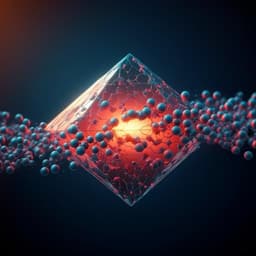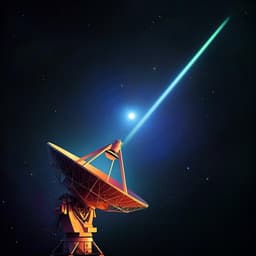
Engineering and Technology
A quantum radio frequency signal analyzer based on nitrogen vacancy centers in diamond
S. Magaletti, L. Mayer, et al.
Discover the groundbreaking Quantum Diamond Signal Analyzer (Q-DISA), developed by Simone Magaletti, Ludovic Mayer, Jean-François Roch, and Thierry Debuisschert. This innovative device detects RF signals across a 25 GHz range with millisecond temporal resolution, harnessing the unique spin properties of nitrogen-vacancy centers in diamond for unparalleled performance.
~3 min • Beginner • English
Introduction
The paper addresses the need for compact, low-power, room-temperature tools capable of real-time, broadband microwave (MW)/RF spectral analysis with 100% probability of intercept. Conventional FFT-based electronic spectrum analyzers are limited by ADC sampling rates and power consumption to real-time bandwidths of a few hundred MHz, while photonic approaches can extend bandwidth to tens of GHz but often require cryogenic operation. NV centers in diamond offer room-temperature quantum sensing capabilities. The authors propose a Quantum Diamond Spectrum Analyzer (Q-DiSA) that spatially encodes NV spin resonance frequencies via a static magnetic field gradient, enabling direct optical detection of MW spectra without digitization. They overcome prior limitations (limited tuning range due to misalignment of magnetic field with NV axis) by combining a specific diamond cut with a simplified magnet arrangement that maintains alignment during tuning, enabling wide tunability (≈25 GHz), MHz-scale frequency resolution, millisecond temporal resolution, and large dynamic range.
Literature Review
The authors review: (1) Real-time FFT electronic spectrum analyzers that achieve ~500 MHz instantaneous bandwidth, frequency resolution of hundreds of kHz, microsecond POI, and >70 dB dynamic range but are constrained by ADC sampling rate and power consumption. (2) Analog photonic techniques, including spectral hole burning in ion-doped crystals at cryogenic temperatures, offering tens of GHz bandwidth, ~100 kHz resolution, and >50 dB dynamic range, yet requiring cryocoolers. (3) NV center-based sensing as a room-temperature alternative. Prior NV-based MW spectral analysis demonstrated only hundreds of MHz range due to magnetic architecture not aligned with the NV axis. The present work addresses this by aligning the magnetic field with the NV axis using a specific diamond cut and simplified magnet geometry, enabling broad tunability without degrading NV photophysics from transverse fields.
Methodology
Principle: The device uses an ensemble of NV centers in diamond as spin-1 systems with ground-state zero-field splitting D≈2.87 GHz. A static magnetic field B aligned with one NV family axis induces Zeeman-shifted transitions ν±=D±γ B_NV (γ≈28 GHz/T). A spatial magnetic field gradient encodes resonance frequency across the diamond so different positions correspond to different MW frequencies. Under continuous-wave (CW) optical pumping (532 nm), NV photoluminescence (PL) decreases when MW components are resonant (ODMR), enabling spatially multiplexed spectral detection using a camera.
Set-up: A single-crystal diamond with a {110} facet and specific cut is illuminated by a 532 nm laser (300 mW; beam waist ~40 µm; saturation parameter s≈0.15). PL is collected through an objective; a spatial filter in the detection path suppresses PL from off-axis NV families to enhance contrast of the on-axis family. A spherical permanent magnet generates the static field aligned along one NV family lying in the {110} plane; tuning is achieved by changing magnet-diamond distance, which sets the central frequency and gradient. A 1 mm-diameter loop antenna (constructed from coax shorted with a 50 µm wire) delivers a near-homogeneous, linearly polarized RF magnetic field; placed to maximize coupling to the selected NV orientation. The active imaging area is ~530×50 µm² with pixel resolution ~0.66×0.66 µm², chosen to balance bandwidth (field of view) and frequency resolution (set by spatial resolution and linewidth).
Calibration and readout: For a fixed magnet position, CW-ODMR is acquired by sweeping RF frequency while imaging PL, mapping each pixel (or iso-B pixel set) to a resonance frequency. Wide-field imaging allows summing over all pixels resonant at the same frequency (iso-B contours) to boost SNR. The shot-noise-limited SNR scales as SNR = sqrt(n V N_p R_p ζ Δt C), where n is NV concentration, V pixel volume, N_p the number of resonant pixels, R_p PL rate, ζ collection efficiency, Δt integration time, and C ODMR contrast. For spectral analysis, masks for each frequency select corresponding pixels, and the spectrum S(ν)=Σ_{x,y} I(x,y) M(x,y,ν) is computed (a sum implementable on FPGA for real-time processing). Acquisition uses repeated RF frequency ramps to average and improve SNR; normalization extracts contrast.
Spectral operation: Central frequency is set by magnet distance; bandwidth by the magnetic gradient across the field of view. Example configurations demonstrate bandwidths from hundreds of MHz at low central frequencies to ~4 GHz around 22 GHz. Frequency resolution is determined by NV ensemble linewidth including intrinsic (~500 kHz), power broadening (laser and MW power), and inhomogeneous broadening from spatial field gradients and setup stability (vibrations, magnet temperature). Hyperfine structure (14N, 2.14 MHz splitting) is resolved at low gradient and low MW power; at higher gradients or power, lines broaden and merge. Continuous-wave operation provides simultaneous detection of all frequencies in the field of view with no dead time other than camera refresh, enabling 100% POI.
Key Findings
- Tunable frequency range: Practical coverage from ~10 MHz (limited by GSLAC mixing) up to 27 GHz (limited by permanent magnet field), with overall tunability of ≈25 GHz. Instantaneous bandwidth up to 4 GHz around 22 GHz; ~300 MHz around 150 MHz.
- Frequency resolution: As low as ~1 MHz FWHM at 2.6 GHz (limited close to intrinsic linewidth); ~50 MHz FWHM at 21 GHz due to higher gradient and inhomogeneity. Hyperfine triplet (2.14 MHz spacing) resolved at low gradient and power.
- Dynamic range and amplitude detection: Detectable power range from about +23 dBm down to −17 dBm at the instrument input, corresponding to ~40 dB dynamic range (noise-floor limited). Contrast increases linearly with MW power at low levels and saturates at higher power. Demonstrated characterization of a MW generator’s non-linearity; Q-DISA spectrum consistent with a commercial spectrum analyzer.
- Temporal resolution: Using Eq. (2) and reducing exposure time, measured time resolutions (not including camera refresh) of ~2 ms at 1.8 GHz (C≈6%, SNR≈5), ~20 ms at 9 GHz (C≈1%, SNR≈4), and ~600 ms at 23 GHz (C≈0.1%, SNR≈1). Temporal resolution degrades at higher frequencies due to reduced contrast.
- Simultaneous detection and POI: Spatial multiplexing enables real-time detection of multiple simultaneous frequency components across the field of view with 100% probability of intercept; the number of resolvable channels is set by bandwidth-to-resolution ratio.
- SNR scaling: Summing PL over iso-B pixels increases SNR approximately as sqrt(N_p) until limited by beam inhomogeneity beyond ~40 pixels in the demonstrated setup.
Discussion
The Q-DiSA directly addresses the limitations of traditional electronic and photonic spectrum analyzers by providing room-temperature, low-power, compact, real-time broadband MW spectral analysis. The key architectural innovation—using a diamond with a specific crystallographic cut and a simple magnet arrangement—keeps the static magnetic field aligned with the NV axis during frequency tuning, enabling broad tunability without degrading NV photophysics. Spatial encoding of resonance frequencies combined with wide-field imaging yields simultaneous, dead-time-free detection across the instantaneous bandwidth with 100% POI. The achieved MHz-level frequency resolution (down to ~1 MHz) and millisecond temporal resolution (down to ~2 ms) demonstrate practical performance, while the ~40 dB dynamic range makes the approach suitable for characterizing real RF sources, including non-linearities. The frequency resolution and temporal performance are frequency-dependent due to gradient-induced broadening and contrast reduction at higher fields. Nonetheless, the results validate NV-based Q-DiSA as a viable approach for real-time broadband spectral analysis at room temperature.
Conclusion
An ensemble of NV centers in diamond can serve as a room-temperature, low-power Quantum Diamond Signal Analyzer for real-time MW spectral analysis. The system achieves tunability over ≈25 GHz (≈10 MHz to 27 GHz), instantaneous bandwidths up to 4 GHz, frequency resolution down to ~1 MHz at low frequencies, millisecond temporal resolution, and ~40 dB dynamic range with 100% POI. Performance stems from maintaining magnetic-field alignment with an NV axis using a specific diamond cut and simplified magnet geometry, enabling stable frequency tuning and strong ODMR contrast. Future improvements include enhanced optical collection, more flexible and independently tunable magnetic-field amplitude and gradient, optimized pumping parameters, higher NV concentrations, and preferential NV orientation to mitigate frequency ambiguities. Employing heterodyne mixing can extend the effective frequency coverage well beyond 25 GHz, potentially to several tens of GHz, while maintaining real-time operation.
Limitations
- Lower frequency limit (~10 MHz) set by ground-state level anti-crossing (GSLAC) mixing between |0⟩ and |−1⟩, which disrupts the one-to-one frequency–field mapping.
- Upper frequency limit (~27 GHz) constrained by the maximum static field achievable with the permanent magnet (could be extended with stronger, e.g., cryogenic, magnets).
- Frequency resolution limited by magnetic-field gradient-induced inhomogeneous broadening, optical/MW power broadening, and setup instabilities (mechanical vibrations, magnet temperature fluctuations). Resolution worsens at higher frequencies (e.g., ~50 MHz at 21 GHz).
- Frequency-dependent contrast reduces temporal resolution at higher frequencies; SNR and time resolution governed by shot noise and contrast via SNR scaling.
- Frequency ambiguities: additional ODMR lines from non-aligned NV families and dual transitions (|0⟩→|−1⟩ and |0⟩→|+1⟩); can be mitigated by preferential NV orientation and MW filtering but may restrict usable instantaneous bandwidth (≤5.74 GHz) per transition.
- In the demonstrated single-magnet architecture, bandwidth and central frequency are coupled, limiting independent optimization of gradient and field strength; beam inhomogeneity limits SNR gains when summing over large pixel areas.
Related Publications
Explore these studies to deepen your understanding of the subject.







